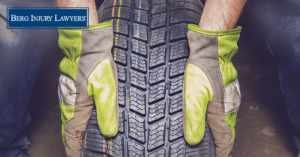November 10th, 2023

Originally published June 8, 2020.
The cost of replacing broken or worn-out car parts can place a burden on many vehicle owners’ wallets. To reduce those costs, some vehicle owners turn to used or refurbished parts. Though some vehicle parts are more likely to be reused than others, many consumers still balk at the idea of purchasing used—also called retread or recapped—tires.
Consumer reluctance to buy used tires is understandable. For years, retread tires had a reputation as being unreliable, if not downright dangerous. Although tire manufacturing has advanced significantly in recent years, making used tires more capable of performing like new tires, the question remains: should consumers still approach recapped tires with skepticism?
Before we look at the current state of retread tires in the marketplace, let’s address a commonly asked question by vehicle owners in California: are retread tires legal to purchase or install on your vehicle?
ARE RETREAD TIRES LEGAL IN CALIFORNIA?
Retread tires must have a tread pattern that complies with Section 27465 of the Vehicle Code. They can’t be used on the front wheels of a bus or farm labor vehicle. They also can’t be used on the front wheels of semi-truck tractors or motortrucks unless they meet the requirements of the state. For passenger vehicles, retread tires are allowed.
WHAT DOES THE STATE GOVERNMENT SAY ABOUT RETREAD TIRES?
California doesn’t just condone the use of retread tires; they encourage them, especially because they offer environmental benefits. Retreading a tire requires fewer raw materials than manufacturing a new one. A retread tire is also one less tire that needs to be thrown away. California’s Department of Resources Recycling and Recovery says that retread tires are commonly used on:
- Commercial and military jets
- Delivery and postal service vehicles
- Fire engines
- Taxis
- Race cars
- Some types of commercial vehicles
SHOULD YOU TRUST RETREAD TIRES?
So, the Department of Resources Recycling and Recovery sings the praises of retread tires, and they’re legal for use on many vehicles in our state—what does that mean for consumers? Should you feel comfortable buying a retread tire instead of a new one? Before you become a retread tire devotee, it’s important to understand that not all retread tires are created equally.
If a tire is retread properly, it is generally safe. However, the quality of a retread tire depends on the person or business performing the retread. Simply put, when it comes to recapped tires, it’s very much a buyer beware situation. If you’re considering buying recapped tires, do your research on the vendor performing the retread to make sure they are trustworthy.
IT’S OKAY TO HAVE RESERVATIONS ABOUT RETREAD TIRES
If you still count yourself among consumers who greet the idea of buying recapped tires with skepticism, that’s okay. The sordid history of these tires, along with anecdotes of vehicle accidents caused by retread tire blowouts, should give any tire buyer pause. You might even be concerned about the safety of retread tires on other vehicles, and we share your concerns.
Retread tires are a frequently discussed topic among commercial trucking companies. Many of these companies have fleets upon fleets of vehicles, and that means they need a large number of tires to place on their trucks. To reduce maintenance costs of fleets, trucking companies look to solutions like retread tires. As we’ve mentioned, retread tires aren’t inherently dangerous if they’re retread properly, but if an 18-wheeler is equipped with dangerous tires, it places many motorists at risk for a crash.
WHAT ARE THE SIGNS OF AN UNSAFE USED TIRE?
If you’re in the market for retread tires, learn how to identify the ones that are safe and those that could put you at risk. Section 9889.30 of the Business and Professions code provides a helpful outline of what constitutes an “unsafe used tire.” Some of the warning signs include:
- Tread Depth Below 2/32 Inch: The tread on your tire should never fall below 2/32 inch. To test this, insert a penny upside-down into the tread groove—if you can see all of Lincoln’s head, the tread is too shallow and the tire is not safe.
- Uneven Tread Wear: Patterns of uneven wear, such as high and low areas or particularly smooth sections, can lead to a potentially unsafe driving experience.
- Visible Internal Components: If you can see the internal components of the tire, such as the cords or steel belts, the tire is definitely unsafe.
- Damage in Critical Areas: Check for cuts, cracks, bulges, or bubbles, especially in the tread shoulder, belt edge area, sidewall, or bead area. These blemishes could suggest structural damage that could lead to tire failure.
- Patches or Repairs: While minor repairs aren’t necessarily a deal-breaker, avoid tires with patches or repairs close to the tread shoulder, belt edge area, sidewall, or bead area.
In addition, if you test the tire and notice unusual vibrations or bumps while driving, this could be a sign that the tire is internally damaged or not properly balanced. Remember, tires are the only point of contact between your vehicle and the road, so you should never feel uncertain about their condition and performance.
CHOOSE A QUALITY RETREAD SHOP
Choose a safe tire retreading and repair shop to ensure your retreaded tires will be reliable and roadworthy. Here are key factors to consider when selecting a retread shop.
- Adherence to Industry Standards: A trustworthy retread shop should comply with the standards set by organizations such as the Retread Tire Association (RTA), the Tire Industry Association (TIA), or the Tire Retread & Repair Information Bureau (TRIB). Certification or memberships with these organizations indicate that the shop follows best practices for tire retreading.
- Reputation and Reviews: Established retread shops that have been in business for several years are more likely to have refined their processes and customer service. Check out the history of the shop, search online reviews, and ask for customer testimonials.
- Process and Safety Checks: Inquire about and observe the shop’s operations if possible. A visit to the facility can provide insights into the level of professionalism maintained, and the staff should be knowledgeable and willing to discuss their inspection process and warranty offerings.
IF RETREAD TIRES CAUSE A CRASH, WHO CAN BE HELD LIABLE?
Crashes stemming from retread tires typically involve blowouts. Determining liability in these types of crashes can be complicated. In some cases, the company that retread the tire could be held responsible. If the tire wasn’t properly maintained by its owner, they might also bear responsibility.
So, if you buy a retread tire, make sure that the vendor is reputable and that you maintain the tire in accordance with instruction from the vendor or manufacturer. If, on the other hand, you are injured in a crash where another driver’s tire blows out, keep in mind that you deserve compensation for the costs you face.
IF YOU NEED LEGAL HELP, CONTACT BERG INJURY LAWYERS TODAY
For nearly 40 years, we’ve helped thousands of people across Northern California get the compensation they deserve from insurance companies. We represent clients who are badly injured in vehicle accidents, including motorcycle, passenger car, and commercial vehicle accidents. If you or a loved one has been involved in a crash and you need an experienced legal advocate on your side, contact the California auto accident attorneys at Berg Injury Lawyers. Our consultations are always free, and we’ll charge no fee unless we win you compensation.


